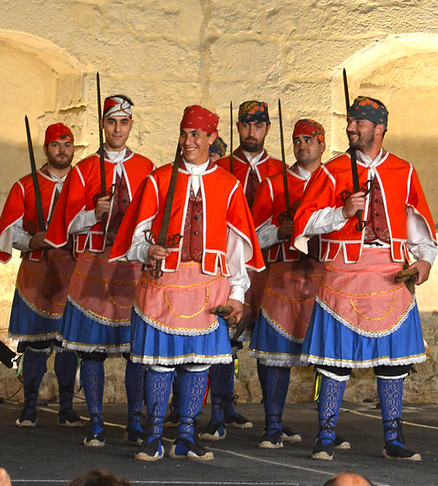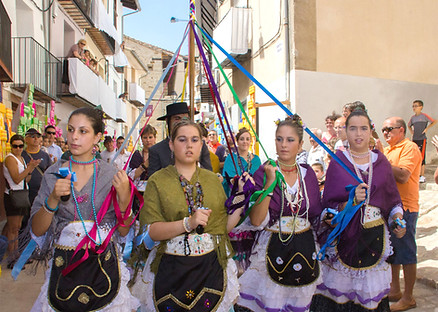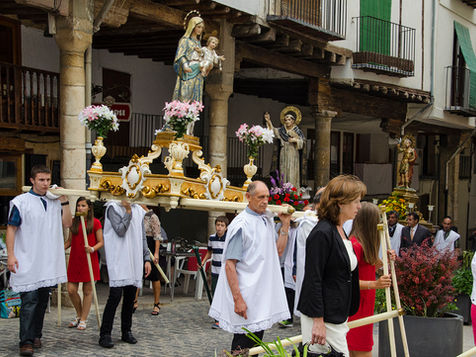
PARTIES
OUR CULTURAL IDENTITY
The festive calendar of the region of Els Ports has numerous essential dates throughout the year. Singular celebrations, that maintain elements that come from the medieval time and a great rootedness in each one of the towns. In addition, in Els Ports you can find dances and cultural events of great importance and that have been the germ of many others that were born later in other places, such as the Warrior Dance of Todolella. Dances, which also value an artisan tradition of the area, with costumes of great value.
In Els Ports, winter is the protagonist of fire and Santantonades, the arrival of spring comes from the hand of the Onso, which gives way to a station full of rogatives. During the summer and autumn, the villages of Els Ports live their most participatory and popular moments with the patron saint festivities. And every six years, there are celebrations that stand out for being incredibly unique and spectacular, such as the Anunci and the Sexenni de Morella. In addition, religious festivities are celebrated in Els Ports, such as Holy Week, Corpus Christi or San Cristóbal.
TRADITIONAL DANCES
The traditional dances of Els Ports have plenty of shared elements, such as the music of the dolçaina and the tabal (typical Spanish shawn and drum), the typical attire of the localities or the tradition of their steps.
Undoubtedly, the most prominent is the popular Dansa Guerrera of Todolella. This is a cultural event of paramount importance, declared Artistic Historical Heritage in 1989. The dance has been represented for centuries and it is full of unique elements and symbols. In it, eight warriors are dressed in traditional costumes dancing the thirteen steps imitating a fight with swords, sticks and shields.
Another traditional dance in Els Ports, which is represented in different localities, are Les Gitanetes. In it, several young ladies wearing traditional clothing dance around a young man holding a stick, weaving their ribbons.
The traditional dances represented in the Sexenni are cultural manifestations of great value. Among these, we can highlight Els Torneros for their impressive dance steps and for being the official dance in the city. This dance is integrated by young men dressed in costumes with Florentine reminiscences. Following the rhythm of the drum and the shawn, they make very difficult steps, such as 180º turns in the air, surprising their viewers. Furthermore, Les Gitanetes, Els Llauradors, Arts i Oficis and Els Teixidors display their spectacular steps during the Novena.
In addition, Els Ports has far more traditional dances, as els varetes and els dansants from Forcall, La dansa dels pastorets in Sorita or different dances that represent special occasions, such as El Ball del Poll, La Dansa del Pastor, El Ball Rodat, Els peregrins or El Ball Plà.



SANT ANTONI
The celebration honouring Saint Anthony Abbot, known as Sant Antoni in the area, is particularly special, being one of the oldest fetivities, which dates back to medieval times. It is the principal festivity during winter, celebrated in all the towns and plenty of shared elements among them, although each one has its uniqueness. The most relevant, since it has conserved medieval elements and has the declaration of Asset of Cultural Interest and Festival of National Tourist Interest, is the Sant Antoni of Forcall, which is always held on the closest weekend to the 17th of January.
Widely known as La Santantonà, it is the festival of fire and the main festivity of the primary sector. This celebration mixes pagan rites with episodes of Christianity. The temptations, the purifying fire and the fight between good and evil are the core of all activities of Sant Antonis.
One shared element in all Santantonades is fire, understood as symbol of purification and renewal of life, burning evil spirits represented by demons. In all town squares, they set up a maio, an enormous construction made with trees and wood, on which are loaded hundreds of pounds of sprouts, forming spectacular huts. These are burned while Botargues or devils dance around.
In many villages, the play “La Vida de Sant Antoni” (“The Life of Saint Anthony”) is represented. It is a dramatisation of the struggle between good and evil, in which Saint Anthony resists many temptations of demons.
The religious origin of the celebration is present in various solemn events such as masses, processions and blessings of animals. There are also fun events and popular representations of tasks as farming, Les Grupes, in which people wearing tradictional clothes ride horses, dances and parties.
The festivities of Sant Antoni also have the typical pastries. As a matter of fact, the majorals, people in charge of organising the festivity, are to harvest pumpkins and prepare a jam to fill dough, which is made from flour, oil, sugar and aiguardent, the traditional liquor.


SEXENNI
Once every six years, Morella fulfills its commitment to its ancestors. Tradition explains that in 1672, a Virgin, known as Mare de Déu de Vallivana, released the town from a severe plague. In gratitude, the agreed to make a Novena in her honour once every six years.
The Sexenni stands out for its magnificence and uniqueness. The streets are embellished with buildings made with curly paper, which makes Morella into a real living museum. It is the climax of the town every six years and, definitely, it is a must.
The town preserves its structure based on gremis, or guilds, and every day of the Novena is organised by one of the gremis in the city. Indeed, in each of these days it is held a procession, known as retaule, in which the different dances from these gremis can be seen with their original steps and their medieval clothes, offering cultural and traditional examples of great value. Els Torneros, Les Gitanetes, Els Llauradors, Arts i Oficis, La Corronquina, and Els Teixidors are the peculiar dances, marching on the street along with representations of El Carro Triomfant, a unique structure filled with children dressed as angels, and El Quadre d’Heroïnes Bíbliques, ladies dressed like biblical heroines, who headed by the Queen Esther. In addition, during the course of the retaule, both visitors and locals can enjoy the Convents, where boys and girls dressed as priests and nuns sing songs with the passage of the processions.
The next Sexenni is to be held on August 2018.



ANUNCI
L’Anunci announces the arrival of the Sexenni. Held one year before the Sexenni, the last Sunday of August. The is to be held on 27th August 2017.
An original and unique festival, where people throw more than 50 tons of confetti, it is a real war for peace. Throughout the weekend, around 40 carriages made with the technique of curling paper, made by Morellan people during the whole year, are exposed to the town. On Sunday morning, it comes El Pregó announcing the arrival of the Sexenni. In the afternoon, at 15 hours, it begins the parade of all participants in L’Anunci. An hour later, approximately, the battle of confetti starts. Morella becomes a sea of confetti and fun.


EL ONSO
L’Onso represents the end of winter and the arrival of spring in La Mata. Then, the hunters start to seek L’Onso (a mythological animal represented by a person dressed in sackcloth and lamb skin and with the face and hands full of fat) in the forest and finally bring him tied to the town. There, L’Onso tries to stain locals and visitors and to escape. This tradition is a great festival and neighbours open their homes and offer food and drinks on the street.
L’Onso is known in places such as the Basque Country or the Pyrenees and, because there is a traditional celebration. Indeed, La Mata has partnered with Prats de Molló, a Catalan-speaking French town where the festival is held.


PILGRIMAGES
With the arrival of spring, a series of events related to the primary sector begin in Els Ports. The pilgrimages trace their origins to medieval times and usually have their shared element in the request for help because there is an upcoming harvest year. Formerly, a good harvest year meant health and prosperity. Thus, between April and June, several pilgrimages, blessings of the region, masses in schrines and popular gatherings take place in the region. As a sign of gratitude for the participation, it is common to give attendees a product made with bread.


CORPUS
CHRISTI
The Corpus Christi is a celebration deeply rooted in some villages of Els Ports. The origin of the Corpus of Morella, for example, dates from 1358, just three years after its beginning in Valencia. The Corpus was born with a pedagogical mission, to show the characters and passages from the Old and New Testament. Today, it still retains its broad biblical content. In Els Ports, this celebration takes place in different locations.


FESTIVITIES
All towns in Els Ports live their peak momen during the patronal feasts. Mainly in the months of August and September or in the autumn, the towns are filled with music, a lively atmosphere and participation during the festivities. The bullfighting events, the music, dinners and evenings and nights full of party play a paramount role during these days. These are weeks of living, when towns recover their glory.


















































